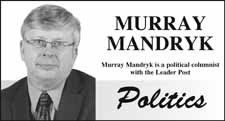A recent conversation with Saskatchewan's foremost statistician, Doug Elliott, reminded me of a couple truisms about rural Saskatchewan that I haven't thought about for awhile:
The first is that it's a little too easy to assume Saskatchewan is one big homogeneous place. This simply isn't case.
The second is that while rural Saskatchewan is more diverse than some realize, what is happening there often becomes the political or economic canary-in-the-coal-mine for the rest of the province.
The topic of conversation was the recent job numbers that showed a remarkable 548,900 working people in Saskatchewan - more than 50,000 more working taxpayers than a decade ago and more than 85,000 more than 20 years ago.
Even more surprising was that there were almost 12,000 more than just a month ago - a surprising statistic, given that oil prices, potash sales and wheat and canola futures haven't exactly been painting a rosy picture for the Saskatchewan economy of late.
When such numbers don't make much sense, journalists like me will often go to Elliott - a gem of guy for us in this business because you can always rely on him for smart, insightful analysis free of government or opposition spin.
Particularly refreshing this time was his usual candour when it came to June's surprising labour force statistics. "Basically, I'm as confused as you are," said Elliott, explaining that all the above indicators should be pointing towards an economic downturn. Elliott speculated that sometimes it takes a while for the job numbers to start reflecting what's going on in the rest of the economy. And it was here where Elliott dug up a few additional numbers that provided some real insight into what may be really going on right.
The breakdown of the employment show that not all areas of Saskatchewan are doing as great as the overall numbers suggest, Elliott explained. For example Regina and Saskatoon continue to boom with construction and growth. And what Statistics Canada defines as the southeast of our province that includes Weyburn and Estevan around the Bakken Play and the potash mining regions to the north are also seeing a sizeable increase in jobs.
But elsewhere in Saskatchewan, job creation is down, Elliott noted. There is a 3.5-per-cent job reduction in the southwest Swift Current-Moose Jaw region. The traditional oil/agricultural area of Kindersley, Rosetown and Bigger has seen a 4.4-per-cent job drop. And in the north where forestry is still suffering, the Prince Albert and north region is experiencing a 1.6-per-cent job drop.
Elliott's observation reminds us that not all of Saskatchewan - in fact, not even all of rural Saskatchewan - is experiencing the same boom right now. And it may be particularly telling that the older oil-drilling regions like Kindersley and Biggar and struggling right now.
When Saskatchewan was starting to recover almost a decade ago, it was actually the rural economy - and specifically, the oil-producing regions of the southwest and west central - that took off first.
That rural Saskatchewan leads the way is nothing new. The same thing has happened politically when the once-solid NDP seats in northeast Saskatchewan around Yorkton start voting Saskatchewan Party in the last 1990s. The rest of the province eventually followed.
Given that it was rural Saskatchewan that the rest of the province has followed out of bad times into economic boom times, the unsettling thing about Elliott's observation is that we may be now witnessing certain parts of rural Saskatchewan leading us back into a less favourable economic trend.
Or maybe the recent numbers are just a reminder that not all of Saskatchewan is the same. Either way, we should be paying attention to the detailed statistics and how they affect rural Saskatchewan.
As a good statistician will tell you, those numbers are trying to tell us something.
Murray Mandryk has been covering provincial politics for over 15 years.




